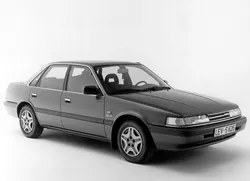

Mazda 626 Generation 3 GD Overview
Explore the Mazda 626 generation 3 GD, showcasing its design, performance, and features. Learn about this iconic model's impact on car enthusiasts in Portugal.
The Mazda 626 Generation 3, known internally as the GD model, is a remarkable representation of Mazda's engineering prowess during the late 1980s to early 1990s. Produced between 1987 and 1992, this vehicle marked a ...
Technical Specifications
Select Version
Dimensions
Engine
Driving
Others
History and Features
Mycarro AI
Apr 26, 2025
The Mazda 626 Generation 3, known internally as the GD model, is a remarkable representation of Mazda's engineering prowess during the late 1980s to early 1990s. Produced between 1987 and 1992, this vehicle marked a significant evolution in design, performance, and technology for the 626 lineup. Building upon its predecessors, the GD offered a more refined driving experience and was instrumental in cementing Mazda's reputation for creating reliable and stylish vehicles.
Design and Aesthetics
The Mazda 626 GD adopted a sleeker and more aerodynamic shape compared to the previous generations. This new design language featured softer curves, a rounded front end, and integrated headlights that gave it a modern appeal. The body dimensions saw a slight increase in length and width, contributing not only to its sporty stance but also to the interior space. Inside, Mazda focused on driver comfort and ergonomics, incorporating higher-quality materials and a more user-friendly dashboard design.
Engine Options and Performance
Under the hood, the Mazda 626 GD was offered with a variety of engine configurations, catering to a broad market audience. The most notable powerplant was the 2.0-liter SOHC four-cylinder engine, which provided a balanced combination of power and fuel efficiency. This engine produced around 88 to 120 horsepower, depending on the specific variant. In addition, the GD model introduced a turbocharged 2.2-liter engine in some markets, delivering a more powerful option for those seeking spirited performance.
Suspension was another area of improvement. The GD featured a front strut and rear multi-link coil suspension system, providing a smooth ride while enhancing cornering stability. This led to a more engaging driving experience, making the Mazda 626 not just a family sedan but also a vehicle that offered both comfort and agility.
Transmission Variants
The GD was equipped with various transmission options, including a 5-speed manual and a 4-speed automatic. This flexibility allowed drivers to choose the best setup for their driving style. The manual transmission appealed to enthusiasts, while the automatic catered to those seeking convenience in urban settings. The overall driving dynamics and transmission choices contributed significantly to its popularity during its production run.
Market Impact and Sales
The 626 GD managed to attract a wide range of customers, from young professionals to families seeking reliable transportation. Mazda's marketing strategy emphasized the model as a blend of reliability, sophistication, and sportiness, enabling it to compete effectively against rivals such as the Honda Accord and Toyota Camry. Its success translated into strong sales figures, with the GD variant becoming one of Mazda’s best-selling models in North America.
Safety Features
Safety was an emerging concern in the late 1980s, and the Mazda 626 GD incorporated various features for its time. Amidst innovations in automotive safety, this model included options such as anti-lock braking systems (ABS) and airbags in later versions, which were groundbreaking features at the time. The development of a robust structure and the positioning of strategic crumple zones added to its crash safety ratings, further enhancing its appeal to safety-conscious buyers.
Legacy and Conclusion
The Mazda 626 Generation 3 left a lasting legacy that influenced subsequent generations of the 626 line. Its successful combination of design, performance, and reliability set a standard for future models. The GD not only helped solidify Mazda's status in the competitive sedan market but also paved the way for future innovations in design and technology as the automotive industry began to evolve rapidly.
Overall, the Mazda 626 GD continues to be remembered fondly by car enthusiasts and former owners alike, representing a pivotal moment in Mazda's history and shaping the compact sedan segment for years to come.
